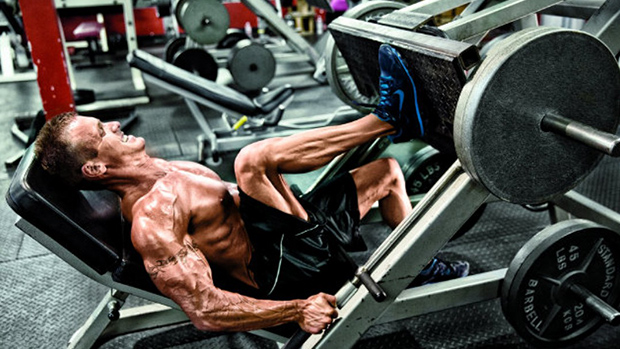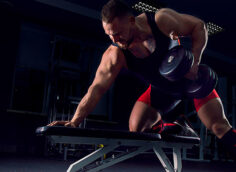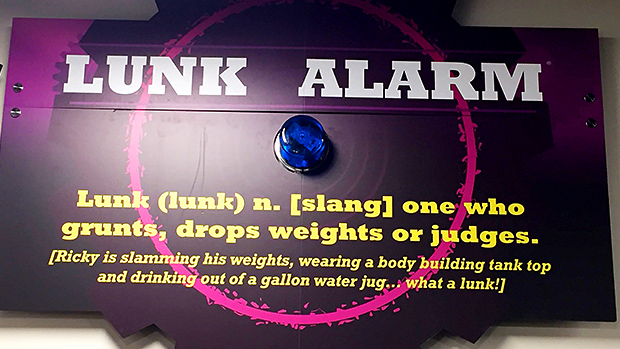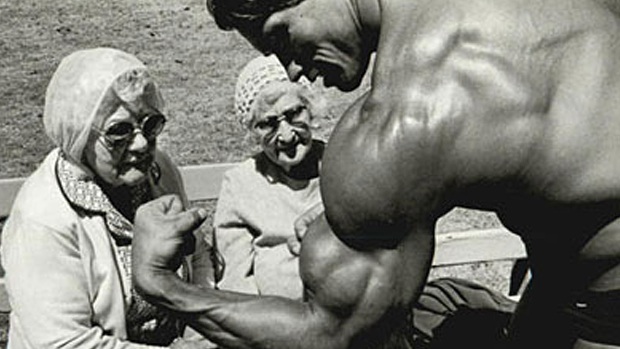Ever watch movies like 300, Gladiator, or Conan the Barbarian and catch yourself wishing you could not only look like the guys on the screen, but kick ass like them, too? If the answer is yes, this program is for you.
So how am I an expert on the pursuit of such noble aspirations?
I grew up watching my share of manly entertainment like football, professional wrestling, The World's Strongest Man, and every movie that Stallone, Arnold, and Van Damme so much as made a cameo in.
Watching my heroes break bones and crack wise, I used to dream of what it would be like to be able to do those sorts of bad-ass things and still be witty and charming, English-speaking skills notwithstanding.
I started training at a local gym in the fall of 1980 when I was 12 and by the time I'd finished high school (1987) gone from 105 pounds to180 pounds and had some respectable lifts for a kid (squat-400/bench-275/dead-365).
I did a few bodybuilding shows in college and eventually hooked up with a group of guys that trained HIT-style. They loved me because I always trained until my head was in a bucket ("Chunk-blower" was my nickname). The low volume HIT training was very abbreviated but frequent, and by the end of 1990 I was a solid 220.
My love of football was still strong, but instead of playing I became an undergraduate assistant strength coach. My boss back then loved the clean and introduced me to some of the Olympic movements. It was here that I also received my first taste of performance training.
I graduated in the fall of 1991 and went on to my first job at a supplement distributor as a salesmen/delivery driver. One of the accounts was a former lifter who encouraged me to try powerlifting.
I trained super heavy, ate every meal like it was my last, and got big and fat. A powerlifter was born! I continued to work for the supplement company and was able to train at hundreds of gyms across the Midwest.
I read everything I could, from the fantasy magazines to the good ones like Hardgainer, MILO, and Powerlifting USA. I studied the writings of Louie Simmons, John Brookfield, Steve Justa, Ken Leistner, Jim Schmitz, Bill Starr, and Pavel Tsatsouline. During meets, trade shows, and other events, I had the good fortune to meet many of them.
From 1991 to1998, I'd play semi-pro football in the summer/fall and powerlifted in the winter/spring, enjoying success in both sports (3x All American, 95 AFA Defensive Player of the Year, 95 & 98 National Powerlifting champion).
I wanted to try strongman outside of the shows I put on locally, so in October of 1998 I did the US Nationals in Vegas. I turned pro and the rest is history.
Since then I've competed against the best in the world over 80 times, and my gym has turned out nine pros, three America's Strongest Man titles, four trips to the WSM, one alternate to the Worlds, and four trips to the North Americans.
So what can you expect to happen by listening to me? To get bigger, stronger, and leaner than ever before!
I've seen thousands of people train in the last 31 years. The stupidity I see usually make me laugh, but this week it made me stop and think. Why don't people make the progress they want?
Removing bad programming from the equation, they simply don't push the limits of their training or nutrition. My suggestion for most is to change their mindset and take the governor off their progress.
Where Ya Headed?
I generally start by asking clients where they want to end up and build the training template from there. I suspect the typical T Nation reader wants to look like they can flip a car and have a legit shot at actually doing it, but also be lean enough to turn heads.
To accomplish this, you need to focus on force development, recoverability, and maximum variation.

Rate of Force Production
Learning how to develop force starts with the Olympic movements and their variations.
In this program you'll do snatches and cleans. This will improve every other aspect of training as you'll be more "in tune" with your nervous system, and the majority of taking off the governor is neural.
Many commercial gyms won't allow you to do Olympic movements. My suggestion is to either change gyms or check out CT's article about Neural Charge Training. It has many movements that can be done anywhere.
Recovery Ability
Science tells us it takes at least 48 hours to recover from an intense workout, although this can vary between lifters. The body's first response to stress is an adaptation, which occurs after recovering and going through the super compensation (growth) phase.
In traditional programming, the whole body is broken down into body parts or types of lifts. This is done so that one can train harder on the specific lift or body part.
The problem with this is systemic recovery. Strength training puts a great deal of demand upon recovery ability beyond just the muscular level.
Lack of systemic recovery can lead to overreaching and eventually over training, neither of which will do anything good for your overall appearance or performance.
Key One: Systemic Recovery
Splitting the body up still draws upon the body's ability to recover systemically, essentially writing checks without knowing how much money is in the bank account.
Savvy lifters attempt to thwart this through scheduled back-off weeks and planned restoration periods, but those weeks tend to be weeks where gains are just being maintained. Call me crazy but I think maintaining sucks, especially when you want constant growth and enhanced performance!
The secret to putting together a program that emphasizes recovery is through full body training. Full body sessions allow you to maximize training frequency while multiple sessions increase work capacity.
But since the key is systemic recovery, here's the twist: you have training "days," not just a single full-body session. You could train up to four times in a day, depending on the goal and time constraints. Most trainees will only require two sessions per day, but extra workouts can be added as an athlete increases his ability to perform more work.
This is what sets this system apart from a typical split routine. With body part splits, each muscle group is trained 4-6 times per month – with a full body system, it can be 12 times per month or more!
As for the day following a training day, that's technically a recovery day – but as long as whatever you're doing doesn't interfere with your body's ability to recover, go for it. Suspension training, conditioning with a Prowler, body weight workouts, and/or band training could be done on the off days.
That's what we mean by taking the governor off!
Key Two: Variety of Big Moves
Big movements and variation is the next key principle. Think of the major types of movement patterns (squat, dead, vertical pull, horizontal pull, vertical press, and horizontal press). How many variations are there? The list isn't quite endless, but it's extensive.
Take the squat, for example: back squat, rack bottom back squat, bottom start back squat, back squat to a box, front squat, Zercher squat, split squat, etc.
Another variation is the kind of reps that can be done. Dynamic reps for speed, Circa Max reps for handling sub maximal but heavy poundage, Max Effort where you grind out the best possible set within a given rep range, and just plain max reps.
Cadence/tempo is another great way to maximize variation, along with adjusting the rest period.
The Turn Off the Governor Template
Here's the basic overview:
You'll have an activation cluster, dynamic effort, a Max Effort cluster, and a Circa Max cluster.
Allow me to hammer this next point home: you have to give your warm up the attention it deserves or you'll pay the price! I strained my right pec doing a muscle up the day my gymnastics rings came in, all because I was an idiot and didn't warm up properly. So plan at least 10 minutes for your warm up – more if you're over 35.
Clusters
I like to use clusters (supersets or giant-sets of combined exercises) when I train.
1 – Activation
Olympic movement: clean or snatch (barbell, dumbbell, hang, block, or from the floor). This varies from workout to workout. The key is change and progress – the more advanced the lifter, the more variation required.
Reps and sets would be either 5x5 or 8x3, but change it up. I use these movements to "prime" the body for what's to come so these will always be done with sub-maximal weights (60-80%).
You can occasionally push the Olympic movements for a new max, but I recommend doing so only once every few months.
The Olympic movements would be clustered with things like reverse hyper-extensions, glute raises, and band work. These movements serve to wake up the big muscles that'll be used later in the session. These are done back to back with little rest between sets.
2 – Dynamic Effort
Speed work is always done directly after the activation work. Depending on what your focus is that day, you could be doing a deadlift, squat, overhead press, or bench press.
There's no cluster here as the speed work doesn't require active recovery. These reps are to be done as explosively as possible and should be timed.
You'll have a target number of sets and reps to do, but you'll also need to keep the bar speed at the correct rate. When the bar speed slows for more than two consecutive sets, it's time to conclude the speed work.
Deadlift: 6-10 singles using between 50-70% of your max pull. Speed should be between .5 seconds and 1 second and timing starts when the bar leaves the floor and ends at lockout. You should do no eccentric work when performing the deadlift, so use bumper plates. Rest 20-45 seconds between pulls.
Press: 5-8 sets of 3 reps using between 50-70% of your max. Speed should be between 3-4 seconds – timing starts on the overhead press when the bar moves off the chest and stops at the lockout of the third rep.
For a chest press, the time starts when the bar begins its descent and ends at the lockout of the third rep. For either type of pressing, rest 20-45 seconds between sets.
Squat: 6-12 sets of 2 reps using between 50-70%. Speed should be between 3-4 seconds – timing starts when the squat is initiated and ends at the lockout of the second rep. Rest 30-60 seconds between sets.
Like the activation work, Dynamic Effort teaches the nervous system to be fast. This portion of the training session won't take long.
3 – Circa Max and Max Effort
With the Circa Max and/or the Max Effort cluster you'll use a few other exercises to work the major movement patterns, provide active recovery, and build muscle.
Auto regulation is the key with these two clusters. You'll start warming up and see how you feel before making the choice to do either Circa Max or Max Effort.
With Circa Max sets, take as many warm up reps as you need to prepare to push some serious weights. Notice I said warm-up reps not sets – do just enough to be ready.
Once you're warm, start with 85% of your current max and do one rep. With Circa Max, do between 3-6 singles at 85-97% of your current max. The key is that you do not miss a rep. It's okay to grind here, but you shouldn't miss.
Note: Here's where you call an audible: if 97% was easy, then Circa Max day could become Max Effort day.
When doing Max Effort work, do just enough to be warm and then try to break your current PR. Your Max Effort work could be for a single, a triple, or a set of five.
Circa Max and Max Effort clusters may be blended together.

Putting It All Together
Here's an example of a typical Turn Off the Governor training day:
- Foam roll – 5 min.
- Active dynamic warm up – 10-15 min.
| Exercise | Sets | Reps |
| Activation Cluster | ||
| Power Snatch | 8 | 3 |
| Reverse Hyper | 5 | 20 |
| Band Face Pull | 5 | 20 |
| Dynamic Effort Cluster | ||
| Push Press | 5-8 | 3 |
| Circa Max Cluster | ||
| Circa Max Trap Bar Deadlift | 3-6 | 1 |
| Pull-Up * | 5 | 6-10 |
| One-Arm Dumbbell Incline Press | 3 | 6-10 |
| Max Effort Cluster | ||
| Max Effort Front Squat | 1 | * * |
| Chest Supported Row | 4 | 6-10 |
* Pull-up – go as heavy as possible while keeping the reps within range
* * Max Effort Front Squat – work up to a max effort set of 5 reps
The Full Turn Off the Governor Template
I realize that many won't have all the equipment I suggest, so I'll include alternate movements where applicable. If you're still scrambling, you need to either find a new place to train or spend a few dollars at Elitefts. There's really no other way.
Weeks 1, 4, 7 and 10
Session 1
| Exercise | Sets | Reps |
| Activation Cluster | ||
| Power Snatch | 5 | 5 |
| Band Face Pull Alternate exercise: suspension face pulls or cable face pulls |
5 | 20 |
| Reverse Hyper Alternate exercise: pull-throughs, stability ball reverse hypers |
5 | 15-20 |
| Dynamic Effort Cluster | ||
| Push Press | 5-8 | 3 |
| Circa Max Cluster | ||
| Front Squat | 3-5 | 1 |
| Chest Supported Row | 4 | 6-10 |
| Incline Press | 3 | 6-10 |
| Max Effort Cluster | ||
| Conventional Deadlift | 1 | * |
| Pull Up | 3-6 | 5 |
* Conventional Deadlift – work up to a max effort set of 3 reps
Session 2
| Exercise | Sets | Reps |
| Activation Cluster | ||
| Power Clean | 5 | 5 |
| Band Dislocation Alternate exercise: broomstick may be used |
5 | 10 |
| Reverse Hyper | 5 | 15-20 |
| Dynamic Effort Cluster | ||
| Trap Bar Dead Alternate exercise: dumbbells may be used |
6-10 | 1 |
| Circa Max Cluster | ||
| Overhead Rack Press | 3-5 | 1 |
| Reverse Grip Chin-Up | 3-5 | 8 |
| Clean-Grip Hang Pull | 3 | 8 |
| Max Effort Cluster | ||
| Squat | 1 | * |
| One-Arm Dumbbell Incline Press | 3 | 6-10 |
* Squat – work up to a max effort set of 5 reps
Session 3
| Exercise | Sets | Reps |
| Activation Cluster | ||
| Hang Snatch | 5 | 5 |
| Band High Row | 5 | 20 |
| Reverse Hyper | 5 | 15-20 |
| Dynamic Effort Cluster | ||
| Box Squat | 6-12 | 2 |
| Circa Max Cluster | ||
| Rack Dead | 3-5 | 1 |
| Parallel Chin-Up | 3-5 | 3 |
| Max Effort Cluster | ||
| Log Press Alternate exercise: barbell push press |
1 | * |
| Hammer Row | 3-5 | 6-10 |
* Log Press – work up to a max effort single
Weeks 2, 5, 8, and 11
Session 1
| Exercise | Sets | Reps |
| Activation Cluster | ||
| Hang Clean | 5 | 5 |
| Band Straight-Arm Pullover Alternate exercise: cable machine straight-arm pullover |
5 | 20 |
| Reverse Hyper | 5 | 15-20 |
| Dynamic Effort Cluster | ||
| Bench Press | 5-8 | 3 |
| Circa Max Cluster | ||
| Viking Press Alternate exercise: one-arm dumbbell jerk |
3-5 | 1 |
| Ring Chin Alternate exercise: any chin-up or pull-up variation |
3-5 | 10 |
| Snatch Grip Hang Pull | 3 | 8 |
| Max Effort Cluster | ||
| Trap Bar Dead | 1 | * |
| Floor Press | 1 | * * |
* Trap Bar Dead – work up to a new max single
* * Floor Press – work up to a new 3-rep max
Session 2
| Exercise | Sets | Reps |
| Activation Cluster | ||
| Dumbbell Snatch | 5 | 5 |
| Band Pull-Apart Alternate exercise: dual cable machine pull-apart |
5 | 20 |
| Reverse Hyper | 5 | 15-20 |
| Dynamic Effort Cluster | ||
| Rack Dead | 6-10 | 1 |
| Circa Max Cluster | ||
| Board Bench Press Alternate exercise: no boards – use a towel rolled up or an aerobic step |
3-5 | 1 |
| One-Arm Dumbbell Row | 3-5 | 6-10 |
| Max Effort Cluster | ||
| Front Squat | 1 | * |
| Pull-Up | 3-5 | 3 |
* Front Squat – work up to a max effort set of 3 reps
Session 3
| Exercise | Sets | Reps |
| Activation Cluster | ||
| Power Clean | 8 | 3 |
| Band Face Pull | 5 | 20 |
| Reverse Hyper | 5 | 15-20 |
| Dynamic Effort Cluster | ||
| Rack Bottom Squat | 6-12 | 2 |
| Circa Max Cluster | ||
| Arched Back Good Morning | 3-5 | 1 |
| Reverse Grip Chin-Up | 3-5 | 5 |
| One-Arm Dumbbell Hang Pull | 3 | 8 |
| Max Effort Cluster | ||
| Axle Push Press Alternate exercise: regular Olympic barbell press |
1 | * |
| Chest Supported T-Bar Row | 4 | 6-10 |
* Axle Push Press – work up to a max effort set of 3 reps
Weeks 3, 6, 9, and 12
Session 1
| Exercise | Sets | Reps |
| Activation Cluster | ||
| Power Snatch | 8 | 3 |
| Band Dislocation | 5 | 20 |
| Reverse Hyper | 5 | 15-20 |
| Dynamic Effort Cluster | ||
| Log Press Alternate exercise: barbell or an axle press |
5-8 | 3 |
| Box Squat | 6-12 | 2 |
| Circa Max and Max Effort Cluster | ||
| Bench Press | 3-5 | 1 * |
| Reverse Band Deadlift Alternate exercise: pull from the rack |
1 | * * |
| Parallel Chin | 3-5 | 8 |
* Bench Press – circa
* * Reverse Band Deadlift – work up to a max effort set of 5 reps
Session 2
| Exercise | Sets | Reps |
| Activation Cluster | ||
| Hang Clean | 8 | 3 |
| Band High Row | 5 | 20 |
| Reverse Hyper | 5 | 15-20 |
| Dynamic Effort Cluster | ||
| Conventional Dead | 6-10 | 1 |
| Circa Max Cluster | ||
| Hammer Delt Press | 3-5 | 1 |
| Ring Chin-Up | 5 | 8 |
| Max Effort Cluster | ||
| Rack Bottom Squat | 1 | * |
| Hammer Row | 4 | 6-10 |
| Dip | 3 | 6-10 |
* Rack Bottom Squat – work up to a max single
Session 3
| Exercise | Sets | Reps |
| Activation Cluster | ||
| Hang Snatch | 5 | 5 |
| Band Pull-Apart | 5 | 20 |
| Reverse Hyper | 5 | 15-20 |
| Dynamic Effort Cluster | ||
| Front Squat | 6-12 | 2 |
| Incline Press | 5-8 | 3 |
| Circa Max and Max Effort Cluster | ||
| Trap Bar Dead | 3-5 | 1 * |
| Viking Press Alternate exercise: Smith machine or one-arm dumbbell press |
1 | 5 * * |
| Pull-Up | 3-5 | 10 |
* Trap Bar Dead – circa
* * Viking Press – work up to a max effort set of 5 reps
Take the Governor Off!
Sorry friends, but for the natural trainee, bodypart splits have gone the way of Zubaz pants and fanny packs. Remove the mental barriers from your training program and start realizing your true physical potential.
Now get training!





